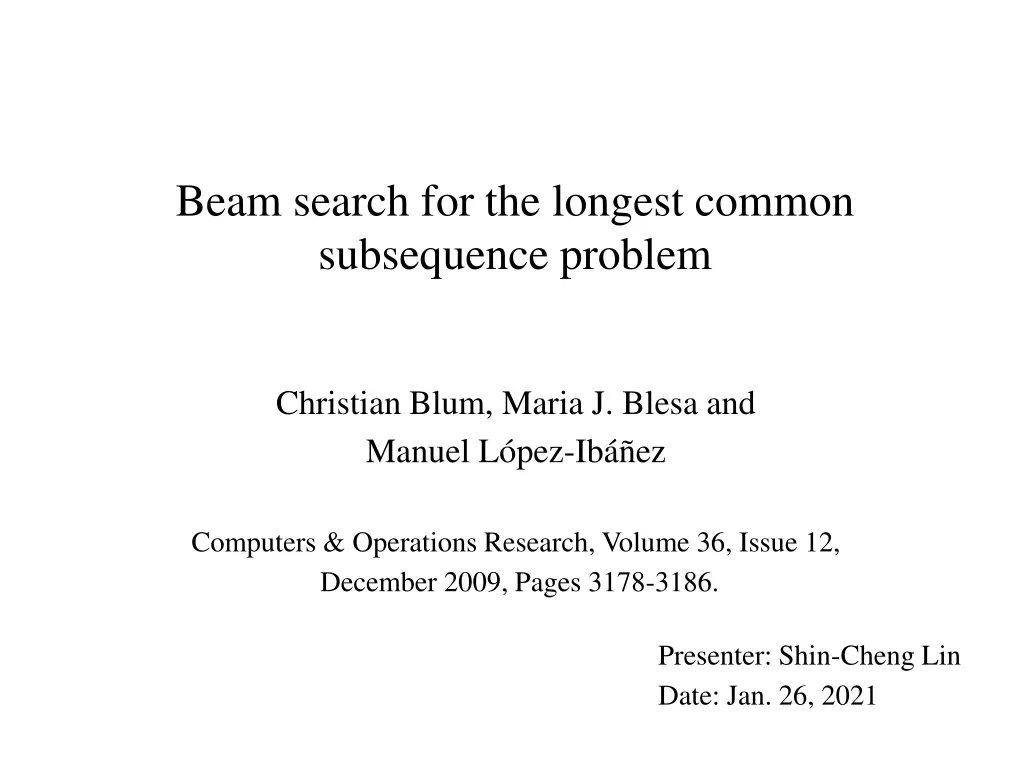
Beam Search for Longest Common Subsequence Problem Insights
"Explore a deterministic beam search algorithm for the longest common subsequence problem, offering superior solution quality and efficiency compared to existing approaches. Discover how this algorithm enhances pattern recognition and computational biology applications."
Download Presentation

Please find below an Image/Link to download the presentation.
The content on the website is provided AS IS for your information and personal use only. It may not be sold, licensed, or shared on other websites without obtaining consent from the author. If you encounter any issues during the download, it is possible that the publisher has removed the file from their server.
You are allowed to download the files provided on this website for personal or commercial use, subject to the condition that they are used lawfully. All files are the property of their respective owners.
The content on the website is provided AS IS for your information and personal use only. It may not be sold, licensed, or shared on other websites without obtaining consent from the author.
E N D
Presentation Transcript
Beam search for the longest common subsequence problem Christian Blum, Maria J. Blesa and Manuel L pez-Ib ez Computers & Operations Research, Volume 36, Issue 12, December 2009, Pages 3178-3186. Presenter: Shin-Cheng Lin Date: Jan. 26, 2021
Abstract The longest common subsequence problem is a classical string problem that concerns finding the common part of a set of strings. It has several important applications, for example, pattern recognition or computational biology. Most research efforts up to now have focused on solving this problem optimally. In comparison, only few works exist dealing with heuristic approaches. In this work we present a deterministic beam search algorithm. The results show that our algorithm outperforms the current state-of-the-art approaches not only in solution quality but often also in computation time.
kbw=2, =1.5 Each step choose maximally 2*1.5=3 extensions of the subsequences that are in the beam B.
Step 1 Choose the three extensions of the empty string with minimal rank-sum.
Greedy function (1):The minimum number of remaining characters (2):The reciprocal of the sum of usage rates Larger is better
Rank The order of Greedy function values s1 = bcadcdc s2 = caabadd s3 = bacddcd T= (T+a)=4, rank(ta)=1 (T+b)=3, rank(tb)=3 (T+c)=4, rank(tc)=2 (T+d)=1, rank(td)=4
Rank-sum Used to compare the extensions of different subsequences Smaller is better t= v(ta)=r(t0)+r(ta)=0+1=1 v(tb)=r(t0)+r(tb)= 0+3=3 v(tc)=r(t0)+r(tc)= 0+2=2 v(td)=r(t0)+r(td)= 0+4=4
Step 1 v(ta)=r(t0)+r(ta)=0+1=1 v(tb)=r(t0)+r(tb)= 0+3=3 v(tc)=r(t0)+r(tc)= 0+2=2 v(td)=r(t0)+r(td)= 0+4=4 C={a,b,c}
Step 2 C={a,b,c} kbw=2, the beam width is two, so we have to discard one of the chosen extensions with the minimum upper bound.
Upper bound s1 = bcadcdc s2 = caabadd s3 = bacddcd t={ } UB(a)=|a|+0+0+0+2=3
Upper bound s1 = bcadcdc s2 = caabadd s3 = bacddcd t={ } UB(b)=|b|+1+0+0+2=4
Upper bound s1 = bcadcdc s2 = caabadd s3 = bacddcd t={ } UB(c)=|c|+0+0+0+2=3
Step 2 C={a,b,c} kbw=2, the beam width is two, so we have to discard one of the chosen extensions with the minimum upper bound. UB(a)=3 UB(b)=4 UB(c)=3 T={a,b}
Step 3 Repeat step 1 and step 2 until B={ }
